Furnace
When purchasing a new furnace the company that installs the furnace is a more important consideration than the brand name that is on the furnace.
A furnace is just a part of the system that heats your home and furnishes air flow to cool your house. An 80% or 90% efficient furnace may loose 5% to 15% of its efficiency or more if the rest of the system does not work properly.
Listed below is information that will assure that your new furnace delivers the efficiency that it should.
It is important to do heat load calculations before you install a new furnace.The furnace should be the right size for your house. You or the previous owner may have added insulation, new windows or made other improvements that make you home more energy efficient. A properly sized furnace will give you more comfort and cost less to operate. A properly sized furnace heats your house more evenly! [see heating and cooling load calculations]
The manner in which your furnace is connected to the duct work affects the efficiency of the heating and cooling system. Here are a few examples:
 |
|
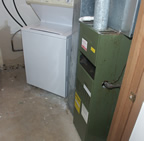 |
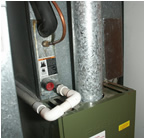 |
| Before: Old single wall flue vent changed to double wall “B” vent | |
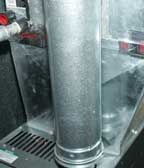 |
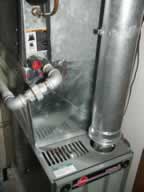 |
|
After Installation: This shows the B Vent when a new furnace is installed |
|
Your ductwork is also an important part of your heating and cooling system Good duct work leaks approximately 10% and poor ductwork leaks as much as 30% or more. In order to have ductwork that leaks less than 10% it is necessary to seal the joints. If you close a damper or register to try to balance the system, all that happens is that the duct work leaks more. You do not get, more air out of the other registers. If the ductwork is tight and you close a damper or a register, more air comes out of the other registers. [Joint sealed with foil tape]
 |
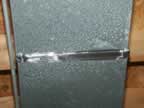 |
|
Not Sealed |
Sealed with foil tape |
If you install a new 80% efficient furnace, and connect the flue of the furnace to a chimney, the chimney must be lined with a metal flue liner. If you do not have a flue liner the condensation from the furnace flue will damage the chimney due to freezing water as well as rust out the heat exchanger in your furnace. In many cases (always if the furnace is two stage) double wall or “B” vent must be connected from the furnace to the chimney or the existing “B” vent that goes up to the roof or the condensation from the flue will rust out the heat exchanger pre-maturely.
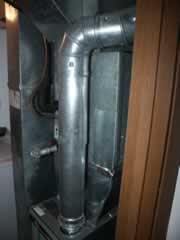 |
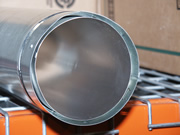 |
| Picture of “B” vent connected to furnace | Double wall “B” vent |
Most filter racks that come with the furnace make it very difficult to change the filter. If the filter is difficult to change it does not get changed as often. We recommend a custom made filter rack that makes it easy to change the filter.
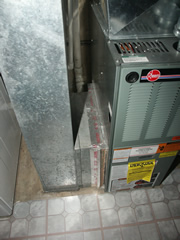 |
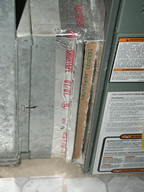 |
| Custom made filter rack | |
Which kind of furnace is best for you. It depends! Furnace manufacturers make 80%, 90%, efficient furnaces as well as two stage, 80% efficient and 90% efficient furnaces. Modulating 90% efficient are also available. Manufacturers make a variety of furnaces because one furnace does not fit everyone’s needs. We will explain the differences between the various types of furnaces so that you select the best furnace for you. One of the more important questions is how long do you plan to stay in your home?
If the construction of the house is tight, it is recommended that combustion air be supplied for the furnace. Combustion air is air that is supplied to burn the gas at the burners. A lack of combustion air causes incomplete combustion. If the proper amount of combustion air is not supplied to the furnace, the result can be carbon monoxide. A flue problem can also be a serious health risk and can result in death due to carbon monoxide. There are several ways to protect your self.
If you do not have a carbon monoxide alarm, we recommend that you purchase one with a digital read out that indicates the level of carbon monoxide in parts per million. If it is more than a few years old make sure that it works! Check the manufacturers instructions. Place the carbon monoxide alarm where you can hear it if you are sleeping.
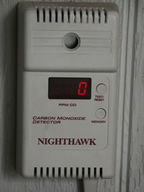 |
The problem with a tight house is that if the kitchen or bathroom exhaust fan is on, or a clothes dryer is running, air is removed from the house. The replacement air will come in down the chimney or flue if the house has tight construction. This can cause large amounts of carbon monoxide to be formed when the furnace is running.
There are three ways to insure combustion air for the furnace.
First most 90% efficient furnaces have a dedicated combustion air connection to the furnace. This type of furnace should have two large white PVC pipes connected to it. One PVC pipe is for the flue exhaust and the other PVC pipe is for the combustion air. If you have only one PVC pipe coming from a 90% efficient furnace you do not have outside air for combustion.
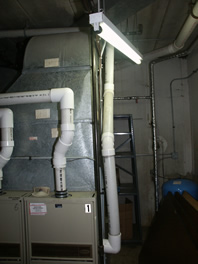 |
 |
|
Pictures of white pvc combustion air and exhaust pipe for 90% efficient furnace |
|
The second method is to have combustion air coming from the attic or from an outside vent into the furnace room. This type of system is generally used with 80% efficient or older furnaces.
 |
| Combustion air pipe coming from ceiling and is shown in the center of the photo |
The third method is to bring in outside air through the furnace duct system by connecting a duct from the outside to the return air duct. Some systems operate the furnace blower three or four times per hour even though the furnace or air conditioner is not operating, to bring in fresh air into the house. There are heat exchangers that can be connected to this type of system to reduce the energy loss of bringing in fresh air from outside.
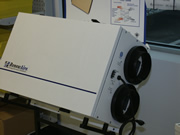 |
|
Picture of heat exchanger used to save energy when bringing in air into house |
We recommend that the furnace that you purchase has a spark ignition system for lighting the furnace rather than a hot surface ignition system.Hot surface igniters have to be replaced as often as every year or two and the cost is between $150 and $200. Consumers have reported that the most common problem with their furnace is due to a malfunction of the ignition system.
We give our customers a one year labor warranty with any furnace installation. Contact us for details.
